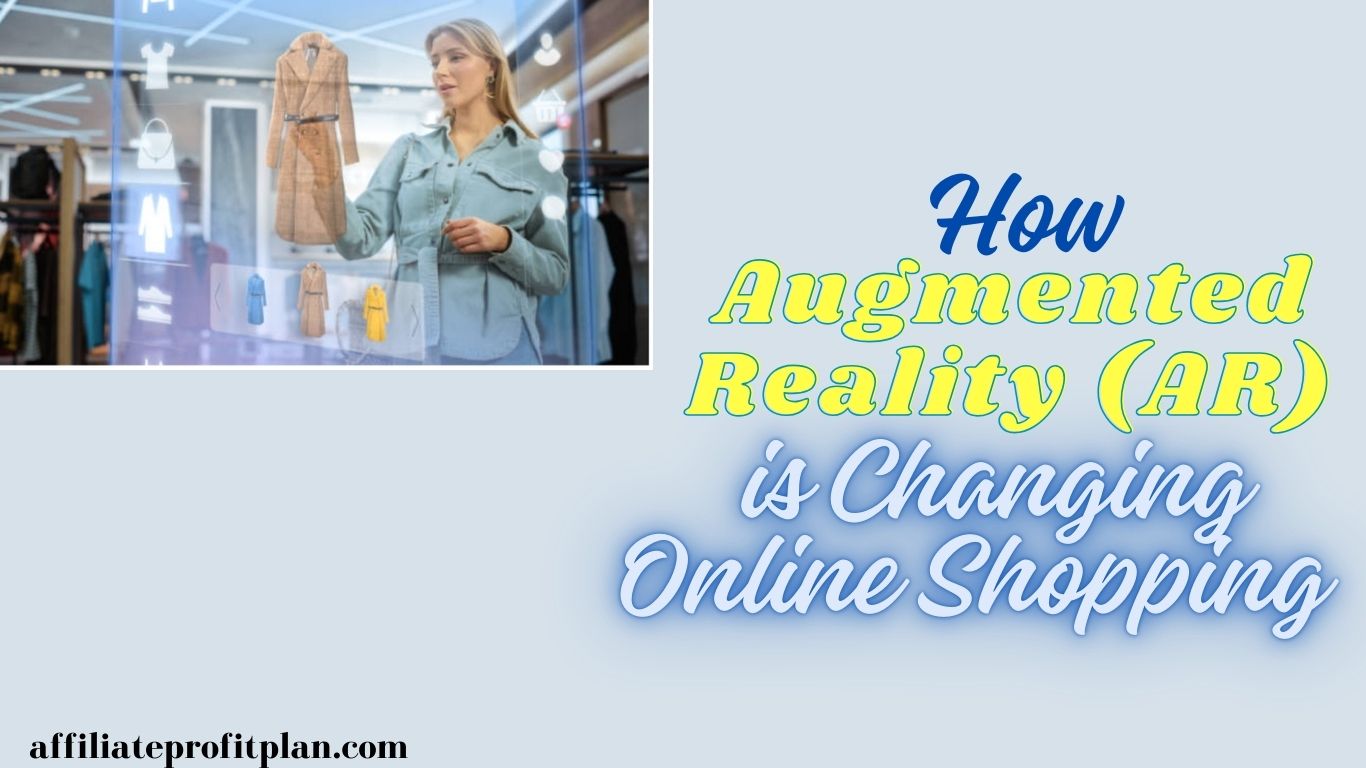Welcome to my article How Augmented Reality (AR) is Changing Online Shopping. Imagine shopping for a new pair of shoes without the hassle of guessing whether they’ll actually look good on your feet. Or buying a couch without the dreaded fear of it turning your living room into a design disaster. Sounds like a dream, right? Well, thanks to Augmented Reality (AR), that dream is now a reality—literally. AR is revolutionizing online shopping by letting customers interact with products in a virtual-yet-realistic way, reducing guesswork and increasing confidence in their purchases. From virtual try-ons to 3D product visualization, AR is bridging the gap between the convenience of online shopping and the assurance of in-store experiences.
So, how exactly is AR transforming eCommerce, and what does the future hold for this immersive technology? Let’s dive into the world of AR-powered online shopping and explore how it’s changing the way we browse, buy, and (thankfully) avoid bad fashion choices.
Access My Proven Blueprint for $50-$100 Daily Income – Watch This FREE Video Now >>>

What is Augmented Reality (AR) in eCommerce?
Augmented Reality (AR) is like giving your online shopping experience a superpower. Instead of just looking at flat images of products and hoping for the best, AR allows customers to interact with 3D models of products in real-time—placing them in their physical space, trying them on virtually, and even seeing how they function. It’s basically the difference between “I think this will look good” and “Yep, this is perfect!” before making a purchase.
Unlike Virtual Reality (VR)—which takes you into a completely digital world—AR enhances the real world by overlaying digital elements onto it. Think of it as shopping with a digital magic wand that lets you preview items in your own space. Want to see how that sleek new coffee table fits in your living room? AR’s got you covered. Curious if those sunglasses will actually suit your face shape? Try them on virtually. With just a smartphone or AR-supported device, customers can get a hyper-realistic shopping experience without stepping into a store (or dealing with pushy salespeople).
Major brands have already embraced AR to enhance the online shopping experience. Companies like IKEA allow customers to place furniture in their homes with the IKEA Place app, while Sephora’s Virtual Artist lets shoppers try on different shades of lipstick without the mess. Even sneaker brands like Nike and Adidas have AR-powered try-ons to make sure your kicks fit just right. As AR technology continues to evolve, it’s becoming clear that the future of eCommerce is not just digital—it’s interactive, immersive, and way more fun.
How AR Enhances the Online Shopping Experience
Let’s be honest—buying things online can sometimes feel like a gamble. Will that dress actually fit? Does that couch really match your decor, or will it look like something out of a bad reality TV makeover? This is where Augmented Reality (AR) swoops in like a shopping superhero, eliminating guesswork and making online shopping way more interactive, immersive, and—dare we say—fun.
1. Virtual Try-Ons: No Dressing Room? No Problem.
AR-powered virtual try-ons let customers see how products look on them, not just on a perfectly styled model. Whether it’s testing out different shades of lipstick (thank you, Sephora!), trying on glasses (looking at you, Warby Parker!), or seeing how those sneakers will look on your feet before hitting “Add to Cart,” AR makes shopping feel a lot more personalized. No more buying three sizes just to return two!
2. 3D Product Visualization: See It Before You Buy It.
Ever ordered furniture online, only to realize it doesn’t fit through the door? AR solves that headache by letting you place virtual 3D models of products in your actual space. Brands like IKEA and Amazon let shoppers see exactly how a couch, table, or lamp will look in their home before making a commitment. It’s like test-driving furniture, but without the awkward showroom experience.
3. Interactive Engagement: More Fun, Less Friction.
Shopping should be exciting, not stressful. AR introduces interactive product experiences, allowing users to zoom in, rotate, and explore products in 360-degree detail. This builds confidence in buying decisions, making shoppers feel more like they’re in a high-tech store rather than just scrolling through product pages.
4. Say Goodbye to Buyer’s Remorse.
Because AR gives customers a “try before you buy” experience, it significantly reduces return rates—which is a win-win for both businesses and consumers. Fewer returns mean happier customers, lower costs, and less waste.
At the end of the day, AR is making online shopping smarter, smoother, and more satisfying. It’s like having a personal shopping assistant—minus the awkward small talk.
The Business Benefits of AR in eCommerce
For online retailers, the biggest challenge is convincing customers to click “Buy Now” with confidence—without letting doubts about size, color, or quality creep in. Enter Augmented Reality (AR), the ultimate conversion booster, giving shoppers a real-world feel of products before they make a purchase. But AR isn’t just a cool feature for customers—it’s a goldmine for businesses, helping brands stand out, increase sales, and reduce costly returns. Here’s why eCommerce companies are jumping on the AR bandwagon.
Access My Proven Blueprint for $50-$100 Daily Income – Watch This FREE Video Now >>>
1. Higher Conversion Rates: Try It, Love It, Buy It.
Customers are far more likely to buy something when they know exactly what they’re getting. AR-powered experiences remove hesitation by letting shoppers visualize products in real-time—whether it’s trying on a pair of glasses or placing a digital version of a sofa in their living room. The result? Conversion rates skyrocket. Studies show that AR-driven shopping experiences can increase purchase rates by up to 94%. That’s not just a boost—that’s a sales explosion.
2. Fewer Returns: Because No One Likes Packing Up a Failed Purchase.
We’ve all been there—ordering something online, getting excited, and then realizing it looks nothing like the pictures. AR helps customers make better-informed decisions, leading to fewer “Oh no, this isn’t what I expected” moments. Brands using AR have seen return rates drop by up to 40%—saving them time, money, and a whole lot of logistical headaches.
3. Stronger Customer Engagement: More Than Just Browsing.
Let’s be real—shopping online can feel a bit… passive. AR makes it interactive, turning a basic scroll-through into an engaging, hands-on experience. When customers can actively explore and test products, they spend more time on a website, increasing the chances they’ll actually buy something. More engagement = more sales. Simple math.
4. Competitive Advantage: Stand Out or Get Left Behind.
With millions of online stores competing for attention, brands need to do more than just offer good products—they need to create unique, memorable shopping experiences. AR isn’t just a feature; it’s a differentiator. Businesses that implement AR early position themselves as innovators, drawing in tech-savvy shoppers and setting themselves apart from competitors still stuck in the static-image era.
5. Brand Loyalty: Keep Customers Coming Back for More.
The more fun and seamless the shopping experience, the more likely customers are to return. AR-driven eCommerce makes shopping interactive and enjoyable, leading to higher customer satisfaction and repeat business. Plus, when shoppers share their cool AR experiences on social media (because let’s face it, trying on virtual sneakers is pretty cool), brands get free organic marketing.
In short, AR isn’t just a cool tech trend—it’s a business powerhouse. It boosts sales, slashes returns, and creates an unforgettable shopping experience that keeps customers coming back. If you’re an eCommerce business and you’re not looking into AR yet, well… it might be time to upgrade your cart.
Challenges and Limitations of AR in Online Shopping
As exciting as Augmented Reality (AR) is for online shopping, it’s not all smooth sailing. While AR has revolutionized the way people shop, it still comes with its own set of hurdles—some technical, some financial, and some that simply boil down to human nature. Businesses eager to jump on the AR train need to be aware of these challenges before diving in. Let’s break down the biggest roadblocks standing between AR and total eCommerce domination.
1. Development Costs: Cool Tech, But at What Price?
Creating high-quality AR shopping experiences isn’t as simple as slapping a filter on a selfie—it requires advanced 3D modeling, interactive design, and specialized development teams. Whether it’s a virtual try-on for clothing or a 3D furniture placement tool, AR implementation can be expensive, especially for smaller businesses. While big brands like IKEA, Sephora, and Nike have the budget to invest in sophisticated AR experiences, many smaller eCommerce stores are left wondering, “Can we afford this?”
2. Device Compatibility: Not Everyone Has the Latest Tech.
For AR to work its magic, users need compatible devices—and not everyone is walking around with the latest iPhone or a high-end Android phone. Some AR experiences require specific apps, high-speed internet, or advanced phone cameras, which can limit accessibility. If customers can’t easily access an AR feature, it quickly goes from being an exciting selling point to a frustrating dead-end.
3. User Adoption: Some Shoppers Just Aren’t Ready.
Let’s face it—some people still struggle to attach a PDF to an email. Expecting every shopper to instantly embrace AR can be wishful thinking. While tech-savvy users might jump at the chance to try on virtual sneakers, others may be intimidated or simply unaware that AR shopping is an option. Brands need to invest in educating their customers through tutorials, demos, and seamless onboarding experiences, or risk having an amazing AR feature that nobody actually uses.
4. Website Performance & Load Times: Speed Matters.
One of the biggest killers of online sales? Slow websites. AR experiences often require heavy 3D assets, real-time rendering, and interactive elements, all of which can slow down load times—especially on mobile devices. If a customer has to wait too long for an AR feature to load, they’re more likely to bounce than buy. Balancing high-quality AR experiences with fast, responsive websites is a challenge that businesses must tackle head-on.
5. Privacy Concerns: Are Shoppers Comfortable with AR?
AR often relies on camera access, facial recognition, and location-based data, which raises privacy concerns among users. Some shoppers may be wary of giving an app access to their camera or storing facial data, even if it’s just for a virtual try-on. Businesses need to be transparent about how they handle customer data and ensure they follow strict security measures to build trust.
Final Thoughts: Is AR Worth It Despite the Challenges?
Absolutely. While costs, compatibility, and adoption hurdles are real challenges, they’re not deal-breakers. The key to making AR work in eCommerce is strategic implementation—starting with small, impactful AR features, optimizing for mobile speed, and educating users along the way. As technology improves and adoption grows, AR will become an essential part of online shopping—but businesses need to be prepared to ride the learning curve first.
Future of AR in eCommerce: What to Expect Next?
If you think Augmented Reality (AR) has already changed online shopping, just wait—it’s only getting started. As AR technology advances, it’s evolving from a cool add-on to an essential shopping tool, blurring the line between digital and physical retail. The next wave of AR innovations is set to make online shopping even more interactive, personalized, and immersive. So, what’s next? Here’s a sneak peek into the future of AR in eCommerce—spoiler alert: it’s looking pretty futuristic.
1. AI-Powered AR: Shopping That Knows You Better Than You Do
Right now, AR lets you try on clothes or place furniture in your living room. But what if it could recommend products based on your personal style, size, or even past purchases? With the integration of Artificial Intelligence (AI), AR experiences will become smarter and more tailored. Imagine a virtual fitting room that adjusts clothing sizes automatically or a beauty app that analyzes your skin tone to suggest the perfect foundation shade. The days of scrolling through endless product pages? Almost over.
2. AR in the Metaverse: The Virtual Mall of the Future
The Metaverse is turning into the next big thing in digital shopping, and AR will be at the heart of it. Instead of browsing a website, shoppers will be able to walk through virtual stores, interact with products, and even try them on in a fully immersive digital space. Think of it as an online mall—but without the parking struggles and long checkout lines. Brands like Nike and Gucci have already started experimenting with AR-powered virtual stores, and this trend is only going to grow.
3. Wearable AR: Shopping Through Smart Glasses
Right now, most AR shopping experiences happen through smartphones, but that’s about to change. With advancements in wearable AR tech (think Apple Vision Pro, Meta’s AR glasses, and other smart eyewear), customers will soon be able to shop hands-free. Picture this: You’re walking down the street, spot someone wearing an amazing jacket, and with a simple voice command, your AR glasses identify it, show you the brand, price, and where to buy it. Shopping literally at the blink of an eye.
4. Augmented Reality Live Shopping: Try Before You Buy—In Real Time
Livestream shopping is already huge, especially in markets like China, where influencers demo products in real time. Now, imagine AR-enhanced live shopping, where viewers can not only see the product being used but also try it on virtually while watching the stream. Shopping through live AR experiences could soon become as common as watching an Instagram Story—but with the added bonus of actually seeing how that new lipstick looks on your face before you buy it.
5. AR Accessibility for Small Businesses: Not Just for Big Brands Anymore
Right now, AR shopping tools are mostly used by big-name retailers with massive tech budgets. But as AR development becomes cheaper and more accessible, expect small and mid-sized businesses to start integrating AR into their online stores. No-code AR tools and plug-and-play solutions will allow even the smallest online shops to offer interactive, 3D shopping experiences. This means more personalized, immersive shopping—no matter where you buy from.
Final Thoughts: AR is Here to Stay
The future of eCommerce is not just digital—it’s interactive, immersive, and hyper-personalized. Whether it’s AI-driven recommendations, virtual shopping malls, smart glasses, or AR-powered live streams, one thing is clear: AR is no longer a luxury—it’s the future of online shopping. And if brands want to stay ahead, they’ll need to start thinking in 3D.
Conclusion: AR is Changing the Game—Are You Ready?
It’s official—Augmented Reality (AR) isn’t just a flashy tech gimmick; it’s redefining how we shop online. What started as a fun way to try on sunglasses or preview a couch in your living room has now become a powerful tool for businesses and consumers alike. From virtual try-ons that reduce returns to AI-driven personalization that makes shopping smarter, AR is bridging the gap between the convenience of eCommerce and the confidence of in-store shopping.
Access My Proven Blueprint for $50-$100 Daily Income – Watch This FREE Video Now >>>
For businesses, the message is clear: adapt or get left behind. AR is no longer reserved for tech giants—it’s becoming more accessible, more affordable, and more essential for brands of all sizes. The companies that embrace AR now will be the ones leading the charge into the future of eCommerce, while those who ignore it might find themselves struggling to keep up.
As AR technology continues to evolve, online shopping will only get faster, more interactive, and way more fun. So whether you’re a shopper who wants to avoid buyer’s remorse or a business looking to boost sales, one thing is certain—the future of eCommerce is augmented, and it’s here to stay.
Thanks a lot for reading my article on “How Augmented Reality (AR) is Changing Online Shopping” till the end. Hope you’ve helped. See you with another article.










